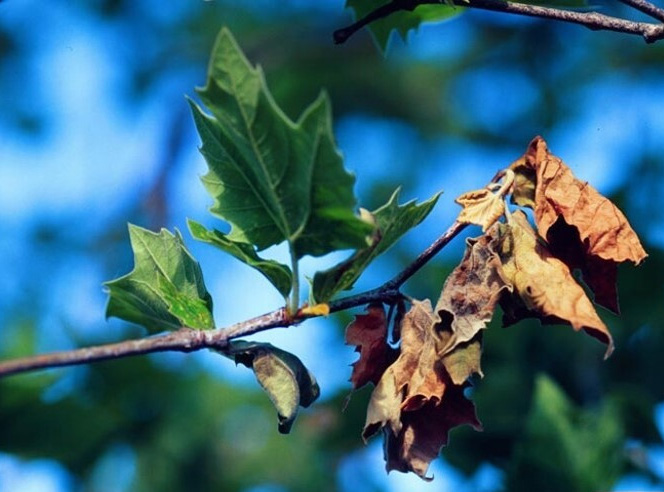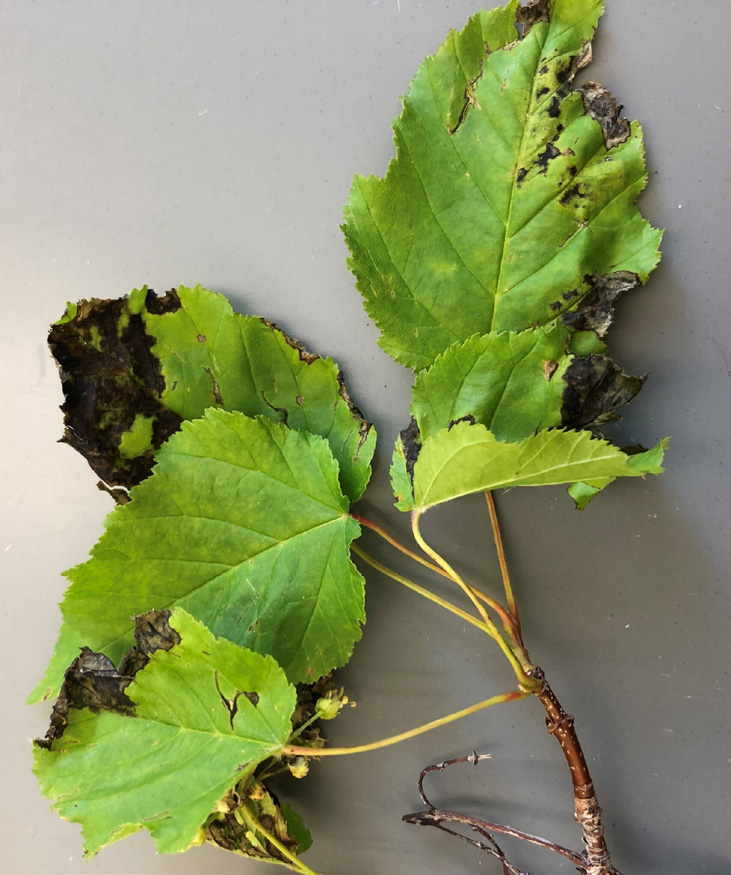Anthracnose (Scientific Name of Pathogen: Colletotrichum gloeosporioides, Discula fraxinea and other host-specific fungi)

Figure 1: Brown necrotic areas on leaves. Photo by Robert L. Anderson, USDA Forest Service, Bugwood.org.
Hosts:
Many shade trees including ash, maple, oak, elm
Damage/symptoms:
Anthracnose is a foliar disease caused by numerous plant pathogenic fungi. In spring, tan to brown blotches appear on new leaves along leaf veins. The blotches enlarge and often cause distortion of the leaves. Young, infected leaves may drop in late spring. Leaves on lower branches are more often affected. Cankers may develop on branches and young shoots may die back. Infection is most severe under cool, wet conditions.
Disease cycle:
The fungus overwinters in infected leaf debris on the ground or in

Figure 2: Shoot dieback caused by anthracnose infection. Photo by Joseph O’Brien, USDA Forest Service. Bugwood.org.
cankers on branches. In spring, spores are produced on the old leaf debris and canker tissues. The spores are dispersed by wind and rain and infect newly emerging leaves. Infection is most severe under cool and wet conditions. New spores are produced on the newly infected leaves which then infect new growth as long as the temperatures stay low and sufficient moisture is available.
Management:
Anthracnose infection does not result in tree death and trees usually push out new leaves by summer. Rake up fallen leaves and prune out infected twigs and branches. Disinfect pruning tools after each cut with 70% ethyl alcohol or a standard household disinfectant spray. Chemical treatments are generally not recommended unless the disease is a continuing problem. High value trees can be protected by applying chlorothalonil-or copper- containing fungicides in early spring when buds first start to open. One to two additional sprays should be applied in 10 to 14-day intervals - strictly follow instructions on the pesticide labels. Infection will slow once the weather becomes dry and the leaves mature.

Figure 3: Necrotic areas on leaves increase in size. Photo by Eva Grimme, Montana Sate UniversityPhoto University
By Eva Grimme, MSU Associate Extension Specialist III. February 2024. For more information,
contact diagnostics@montana.edu.
This March 2024 fact sheet is also available as a printable PDF (445KB).
Disclaimer: These recommendations are provided only as a guide. It is always the pesticide applicator’s responsibility, by law, to read and follow all current label directions for the specific pesticide being used. The authors and Montana State University assume no liability resulting from the use of these recommendations. The Montana State University Extension Service is an ADA/EO/AA/Veteran’s Preference Employer and Provider of Educational Outreach.
